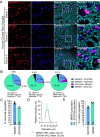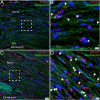This is a preprint.
MNK1 and MNK2 expression in the human dorsal root and trigeminal ganglion
- PMID: 36711529
- PMCID: PMC9881964
- DOI: 10.1101/2023.01.04.522773
MNK1 and MNK2 expression in the human dorsal root and trigeminal ganglion
Update in
-
MNK1 and MNK2 Expression in the Human Dorsal Root and Trigeminal Ganglion.Neuroscience. 2023 Apr 1;515:96-107. doi: 10.1016/j.neuroscience.2023.01.039. Epub 2023 Feb 9. Neuroscience. 2023. PMID: 36764601
Abstract
Mitogen activated protein kinase interacting kinases (MNK) 1 and 2 are serine/threonine protein kinases that play an important role in translation of mRNAs through their phosphorylation of the RNA 5’-cap binding protein, eukaryotic translation initiation factor (eIF) 4E. These kinases are downstream targets for mitogen activated protein kinases (MAPKs), extracellular activity regulated protein kinase (ERK) and p38. MNKs have been implicated in the sensitization of peripheral nociceptors of the dorsal root and trigeminal ganglion (DRG and TG) using transgenic mouse lines and through the use of specific inhibitors of MNK1 and MNK2. While specific knockout of the Mknk1 gene suggests that it is the key isoform for regulation of nociceptor excitability and nociceptive behaviors in mice, both MKNK1 and MKNK2 genes are expressed in the DRG and TG of mice and humans based on RNA sequencing experiments. Single cell sequencing in mice suggests that Mknk1 and Mknk2 may be expressed in different populations of nociceptors. We sought to characterize mRNA expression in human DRG and TG for both MNK1 and MNK2. Our results show that both genes are expressed by nearly all neurons in both human ganglia with expression in other cell types as well. Our findings provide evidence that MNK1 and MNK2 are expressed by human nociceptors and suggest that efforts to pharmacologically target MNKs for pain would likely be translatable due its conserved expression in both species.
Conflict of interest statement
Conflict of Interest Statement
JJS is an employee of 4E Therapeutics and TJP is a founder of 4E Therapeutics, a company developing MNK inhibitors for pain treatment. SS, JJS and TJP are inventors on patents related to MNK inhibition for pain treatment
Figures





Similar articles
-
MNK1 and MNK2 Expression in the Human Dorsal Root and Trigeminal Ganglion.Neuroscience. 2023 Apr 1;515:96-107. doi: 10.1016/j.neuroscience.2023.01.039. Epub 2023 Feb 9. Neuroscience. 2023. PMID: 36764601
-
The MNK-eIF4E Signaling Axis Contributes to Injury-Induced Nociceptive Plasticity and the Development of Chronic Pain.J Neurosci. 2017 Aug 2;37(31):7481-7499. doi: 10.1523/JNEUROSCI.0220-17.2017. Epub 2017 Jul 3. J Neurosci. 2017. PMID: 28674170 Free PMC article.
-
Mitogen-activated protein kinases activate the serine/threonine kinases Mnk1 and Mnk2.EMBO J. 1997 Apr 15;16(8):1909-20. doi: 10.1093/emboj/16.8.1909. EMBO J. 1997. PMID: 9155017 Free PMC article.
-
Mitogen-activated Protein Kinase (MAPK) Interacting Kinases 1 and 2 (MNK1 and MNK2) as Targets for Cancer Therapy: Recent Progress in the Development of MNK Inhibitors.Curr Med Chem. 2017;24(28):3025-3053. doi: 10.2174/0929867324666170203123427. Curr Med Chem. 2017. PMID: 28164761 Review.
-
Progress in developing MNK inhibitors.Eur J Med Chem. 2021 Jul 5;219:113420. doi: 10.1016/j.ejmech.2021.113420. Epub 2021 Apr 2. Eur J Med Chem. 2021. PMID: 33892273 Review.
References
-
- Aguilar-Valles A, Haji N, De Gregorio D, Matta-Camacho E, Eslamizade MJ, Popic J, Sharma V, Cao R, Rummel C, Tanti A, Wiebe S, Nunez N, Comai S, Nadon R, Luheshi G, Mechawar N, Turecki G, Lacaille JC, Gobbi G, Sonenberg N (2018) Translational control of depression-like behavior via phosphorylation of eukaryotic translation initiation factor 4E. Nat Commun 9:2459. - PMC - PubMed
-
- Akopian AN, Sivilotti L, Wood JN (1996) A tetrodotoxin-resistant voltage-gated sodium channel expressed by sensory neurons. Nature 379:257–262. - PubMed
-
- Buxade M, Parra-Palau JL, Proud CG (2008) The Mnks: MAP kinase-interacting kinases (MAP kinase signal-integrating kinases). Front Biosci 13:5359–5373. - PubMed
Publication types
Grants and funding
LinkOut - more resources
Full Text Sources
Miscellaneous
